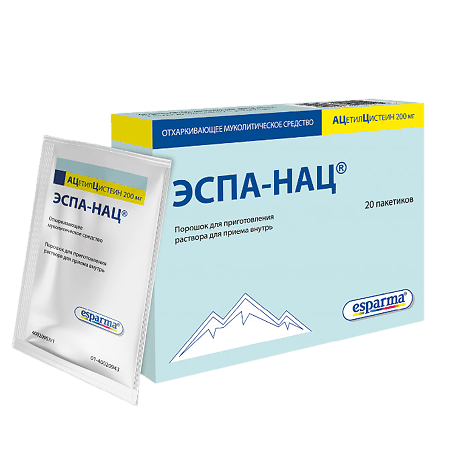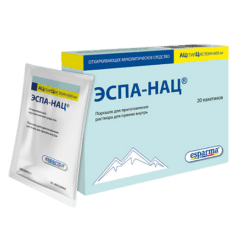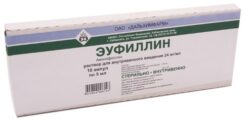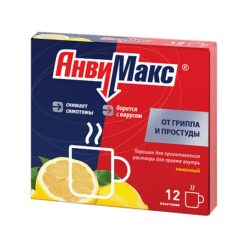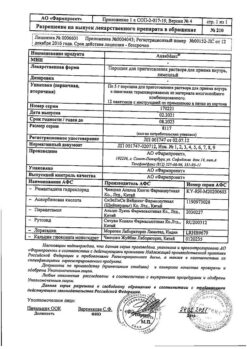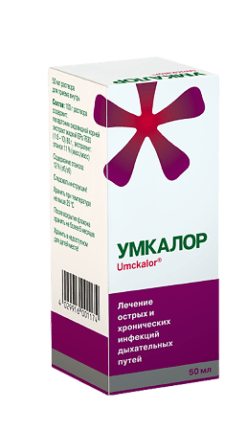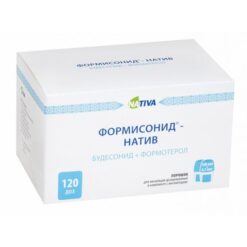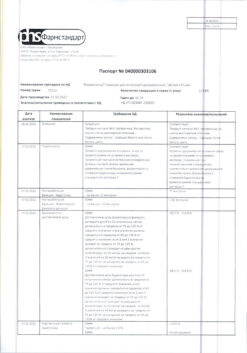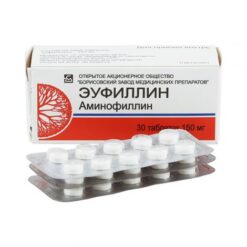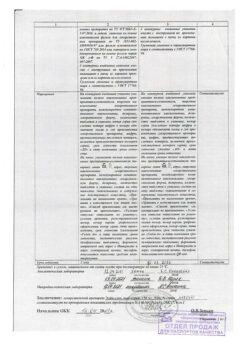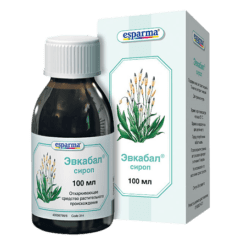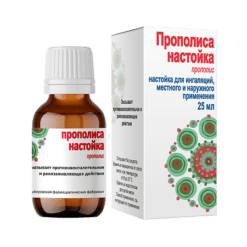No products in the cart.
Espa-Nats, 200 mg 20 pcs
€1.00
Out of stock
(E-mail when Stock is available)
Description
Mucolytic agent, liquefies sputum, increases its volume, facilitates expectoration of sputum. The action is associated with the ability of free sulfhydryl groups of acetylcysteine to break intra- and intermolecular disulfide bonds of mucopolysaccharide chains, which leads to depolymerization of mucoproteins and reduction of sputum viscosity (in some cases this leads to a significant increase in sputum volume, which requires aspiration of bronchial contents).
Contains activity with purulent sputum. Does not affect the immune system.
It increases the secretion of less viscous sialomucin by bocalytic cells, reduces the adhesion of bacteria on the epithelial cells of the bronchial mucosa.
Stimulates bronchial mucosa cells whose secretion lyses fibrin.
It has the same effect on the secretion formed in inflammatory diseases of the ENT organs.
It has an antioxidant effect due to the presence of an SH-group which can neutralize electrophilic oxidative toxins.
It protects alpha-1-antitrypsin (elastase inhibitor) from inactivating effect of BOS1, the oxidizing agent produced by myeloperoxidase of active phagocytes.
It also has some anti-inflammatory action (by inhibiting the formation of free radicals and active oxygen-containing substances responsible for the development of inflammation in lung tissue).
Results in increased synthesis of glutathione, which explains the detoxifying effect in paracetamol poisoning.
When preventive use of acetylcysteine a decrease in the frequency and severity of exacerbations in patients with chronic bronchitis and cystic fibrosis is noted.
Indications
Indications
Respiratory diseases accompanied by formation of viscous sputum difficult to separate:
– acute and chronic bronchitis, obstructive bronchitis;
– tracheitis, laryngotracheitis;
– pneumonia;
– Bronchiectatic disease, bronchial asthma, chronic obstructive pulmonary disease (COPD), bronchiolitis;
– cystic fibrosis.
Acute and chronic sinusitis, inflammation of the middle ear (otitis media).
Active ingredient
Active ingredient
Composition
Composition
1 sachet contains:
the active ingredient:
excipients:
sucrose – 2744.10 mg,
orange flavoring – 50.0 mg,
colloidal silica – 3.00 mg,
tartaric acid – 2.00 mg,
sodium chloride – 0.90 mg.
How to take, the dosage
How to take, the dosage
In the absence of other prescriptions, the following recommendations should be followed. Dissolve the powder in 1 cup of hot water, take orally after meals.
ESPA-NAC® in a dose of 200 mg:
Adults and children over 14 years of age: 2-3 times a day 1 sachet (400-600 mg).
Children 6 to 14 years of age: 2 times daily, 1 sachet (400 mg).
Children 2 to 6 years of age: 2 to 3 times daily with 1/2 sachet (200-300 mg).
In cystic fibrosis:
Children 2 to 6 years: 2 times daily with 1 sachet (400 mg).
Children over 6 years of age: 3 times daily, 1 sachet (600 mg).
Additional fluid intake increases the mucolytic effect of the drug.
In short-term colds, the duration of administration is 5-7 days. In chronic bronchitis and cystic fibrosis the drug should be taken for a longer time to prevent infections. In long-term illnesses, the duration of therapy is determined by the attending physician.
Interaction
Interaction
The concomitant use of acetylcysteine and cough suppressants may lead to mucus congestion due to suppression of the cough reflex.
The concomitant use of acetylcysteine with vasodilators and nitroglycerin may increase the vasodilator effect of the latter.
Pharmaceutically incompatible with antibiotics (penicillins, cephalosporins, erythromycin, tetracycline and amphotericin B) and proteolytic enzymes.
It reduces absorption of penicillins, cephalosporins, tetracycline (they should not be taken earlier than 2 hours after oral administration of acetylcysteine).
Special Instructions
Special Instructions
When dissolving the drug, use glassware, avoid contact with metals, rubber (sulfides with a characteristic odor are formed on contact), oxygen, and easily oxidizing substances.
When treating patients with diabetes it is necessary to take into account that the drug contains sucrose (one sachet of 200/600 mg contains 0.23/0.20 IU, respectively).
In patients with severe skin lesions such as Stevens-Johnson syndrome or Lyell syndrome, fever, body pain, rhinitis, cough and sore throat may occur in the early phase. Mucolytic agents may be prescribed incorrectly when treating symptomatically. There have been isolated reports (< 1/10000) of Stevens-Johnson syndrome and Lyell syndrome coinciding with drug administration; however, there is no causal relationship with drug administration. If the above syndromes develop (sudden onset of rash and spots on the face and torso, which may later spread to other parts of the body), it is recommended to stop treatment and seek medical advice immediately.
In therapeutic doses do not affect the ability to operate vehicles and machinery.
Synopsis
Synopsis
Features
Features
Absorption after oral administration is high. Bioavailability is low – about 10% due to a strongly pronounced effect of “first passage” through the liver with the formation of pharmacologically active metabolite – cysteine, as well as diacetylcystine, cystine.
The maximum level of concentration (Cmax) in plasma after oral administration is reached after about 1-3 hours. Binding to plasma proteins is about 50%. It is mainly excreted by the kidneys as inactive metabolites (inorganic sulphates, diacetylcysteine), a small part is excreted unchanged in the faeces. The elimination half-life (T1/2) of acetylcysteine from plasma is about 1 hour. In liver dysfunction this value increases to 8 hours.
It penetrates through placental barrier, accumulates in amniotic fluid.
There are no data on penetration through the blood-brain barrier.
Contraindications
Contraindications
– Hypersensitivity to acetylcysteine or other drug components;
– Acute gastric and duodenal ulcer;
– hemoptysis, pulmonary hemorrhage;
– Sucrose/isomaltase deficiency, fructose intolerance, glucose-galactose malabsorption (the drug contains sucrose);
– pregnancy;
– lactation;
– children under 14 years of age (for 600 mg dosage), children under 2 years of age (for 200 mg dosage).
Side effects
Side effects
According to the World Health Organization (WHO), adverse effects are classified according to their frequency of development as follows: Very common (⥠1/10), common (⥠1/100, <1/10), infrequent (⥠1/1000, <1/100), rare (⥠1/10000, <1/1000) and very rare (<1/10000); frequency unknown (the incidence of events cannot be determined from available data).
Cardiovascular system side:
Rarely, decreased blood pressure, increased heart rate (tachycardia).
Respiratory system disorders:
very rarely – development of pulmonary bleeding, as a manifestation of hypersensitivity reaction.
Allergic reactions:
rarely – bronchospasm (mainly in patients with hyperresponsive bronchial system in bronchial asthma), skin rash, itching and urticaria, exanthema, angioedema;
very rarely – anaphylactic reactions up to anaphylactic shock, Stevens-Johnson syndrome, toxic epidermal necrolysis.
Gastrointestinal tract:
rarely – stomatitis, abdominal pain, nausea, vomiting and diarrhea, heartburn, dyspepsia.
Sensory organs:
infrequent – tinnitus.
Other:
rarely – headache, fever, single reports of bleeding due to hypersensitivity reactions, decreased platelet aggregation.
Overdose
Overdose
At oral administration of acetylcysteine at a daily dose of up to 11.6 g for three months, no life-threatening side effects were observed. No poisoning has been observed with oral administration of acetylcysteine at doses up to 500 mg/kg body weight.
Symptoms: heartburn and nausea, vomiting, diarrhea, stomach pain. In newborns, there is a risk of developing hypersecretion.
Treatment: symptomatic.
Similarities
Similarities
Additional information
| Conditions of storage | At a temperature not exceeding 25 ° C. Store out of the reach of children. |
|---|---|
| Manufacturer | Lindopharm GmbH, Germany |
| Medication form | Powder for preparation of solution for oral administration |
| Brand | Lindopharm GmbH |
Other forms…
Related products
Buy Espa-Nats, 200 mg 20 pcs with delivery to USA, UK, Europe and over 120 other countries.

